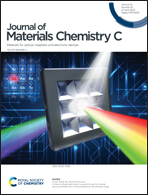A heavily doped germanium pyramid array for tunable optical antireflection in the broadband mid-infrared range†
Abstract
In this work, we report a heavily doped germanium (Ge) inverted pyramid array as a suitable candidate for tunable antireflection in the mid-infrared (MIR) range. Inverted Ge pyramid structures are formed by the metal-assisted chemical etching process. The heavy doping profile in a box shape is obtained via the KrF laser annealing process. The inverted pyramid serves as an effective antireflective surface structure, while the heavy doping layer acts as a high reflector, resulting from the modulated permittivity of Ge. It is observed that the reflectance of the inverted pyramid array made on undoped Ge is suppressed. In contrast, the reflectance of the pyramids after doping is increased in the wavelength range larger than 15 μm. The reflectance is consistent in the wavelength range smaller than 7 μm. A systematic study reveals that the doping concentration and depth are important parameters determining the ability to modulate the reflection spectra. The proposed heavily doped inverted Ge pyramid array paves the way toward a tunable and complementary metal-oxide-semiconductor-compatible antireflection structure in the MIR range.



 Please wait while we load your content...
Please wait while we load your content...